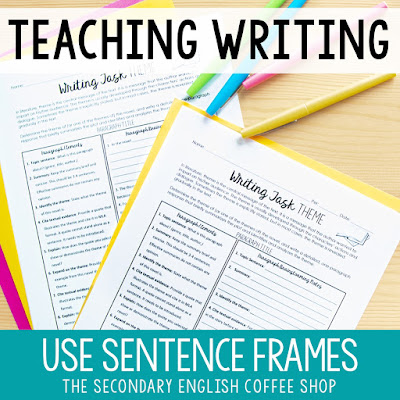We simply do not have enough time to teach students every single thing they need to know in order to be the best writers they can be. However, we can focus on essential skills one at a time to build strong writers.
When I first teach a type of writing to my students, I provide direct instruction and activity-based assignments so that students have an understanding of the genre of writing and what is expected of them. At the beginning of the new unit, I use this ELA writing instructional resource to directly teach students about either argument, narrative, or informational writing, and then we spend time each day working on developing the information using some of the included writing graphic organizers.
In addition to sharing the above resource that I use for teaching writing, this blog post will also include three strategies to help you improve your writing instruction.
Teaching Writing Tip 1: Simplify it and Break It Down
By breaking down the writing process into small, manageable chunks, students are less intimidated and more focused on demonstrating their writing abilities.
You can read more about how I break down writing instruction and snag a free download by reading this post about teaching writing in the secondary ELA classroom.
Teaching Writing Tip 2: Use Sentence Frames
When teachers include sentence frames during their writing instruction, they are teaching students HOW to academically organize and write their ideas.
To read more about using sentence frames in the classroom, you’ll want to visit this blog post about scaffolding writing instruction through the use of sentence frames. This blog post also contains sentence frames that you can use today in your classroom as well as a free sentence frame download!
Teaching Writing Tip 3: Incorporate Grammar
The three biggest grammar lessons that I’ve found help students improve their writing abilities are the parts of speech, dependent and independent clauses, and sentence structure. By focusing a little bit of time on these conventions, your students will become stronger writers.
You can read more about how I incorporate these grammar lessons in my classroom and download a free parts of speech interactive notebook activity by reading this post about helping students improve their writing skills by focusing on grammar.
After incorporating these three strategies into your writing instruction, you might also be interested in three more tips for teaching writing and three strategies to boost student writing.
Teaching Writing Resources:
Writing a Persuasive Essay Portfolio - by the SuperHERO Teacher
MLA Style and Format - by Tracee Orman
Writing Activities - by Presto Plans
Teaching the Process for Literary Analysis - by Room 213


















